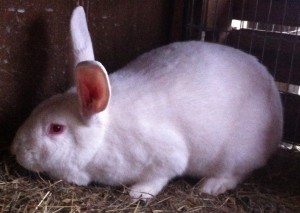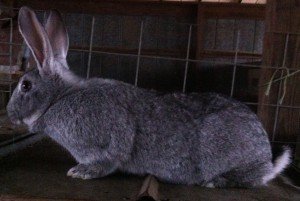Each year on our farm, I try to add one more thing of value. It can either be another big item on our road to self-sufficiency (I bought a fourwheeler one year), a commitment to spend a set amount throughout the year on stored food for our prepping box (rice, flour etc) or an additional animal type to bring in to the farm (such as the Angora goats we bought a couple of years ago for fiber).
This year is the year of the rabbit. I don’t mean the two fuzzy Angora rabbits that I keep for fiber to spin with my mohair, and I don’t mean the (financially unproductive but fun) Dutch bunnies that I raise to show.
 I mean meat rabbits. Some places I hang out, I don’t openly admit that I raise rabbits for meat. These days, it seems to be an invitation for animal rights activists and House Rabbit Society members to wage war against those of us who classify rabbits as livestock. I’m the kind who tends not to stick her head above the parapet when it comes to attracting attention to myself with activist groups, as I am a huge believer in the power of a quiet life.
I mean meat rabbits. Some places I hang out, I don’t openly admit that I raise rabbits for meat. These days, it seems to be an invitation for animal rights activists and House Rabbit Society members to wage war against those of us who classify rabbits as livestock. I’m the kind who tends not to stick her head above the parapet when it comes to attracting attention to myself with activist groups, as I am a huge believer in the power of a quiet life.
As a child, we ate rabbit a lot. And I mean A LOT. In the part of the UK where I grew up, rabbits were prolific vermin, and if you shone a flashlight across our pastures at night, you could see literally hundreds of them nibbling on our sparse grass. Huge rabbit warrens littered the horse pastures. My father would go out at dusk and shoot a handful of them, throwing one to the German Shepherd for dinner and bringing in the rest for us.
It took a lot of persuading by my husband for me to add meat rabbits to the farm, but there was really no way for me to continue to deny it: I have the vegetables thing covered, I have eggs, milk and cheese covered, all we are missing in our arsenal of preparedness and self-sufficiency is meat-based protein. Eventually I conceded: I would give rabbits a try. We tried going the chicken route, but frankly they are dirty, stinky and eat too much. At least with rabbits, I have the ability to pasture raise them. Chickens require so much more, and are far too prone to coccidia and other illnesses for my liking.
Don’t get me wrong, we have spare cockerels roaming the yard who occasionally meet their maker when I forget to take something out of the freezer for dinner, but we don’t raise meat birds specifically. Tried it: didn’t like it. Too high cost, high drag for my liking.
 So rabbits it was. A good friend had been raising them for a little while, and we traded for two American Chinchilla x New Zealand White mixes and a pure American Chinchilla, then I picked up a trio of pure New Zealand Whites from a local breeder. The advice I was given from my friend was to cross breed the two; she was finding that, for meat making purposes, the meat to bone ratio was superior in the cross breed.
So rabbits it was. A good friend had been raising them for a little while, and we traded for two American Chinchilla x New Zealand White mixes and a pure American Chinchilla, then I picked up a trio of pure New Zealand Whites from a local breeder. The advice I was given from my friend was to cross breed the two; she was finding that, for meat making purposes, the meat to bone ratio was superior in the cross breed.
All of my does weigh in at around 10lbs, and are capable of having 8-10 kits per litter. The American Chinchilla features on the Livestock Conservancy’s critical list, so it’s always good to be breeding a heritage animal for its true use and to increase numbers. I hope to breed a litter or two of pure ACs each year, to hopefully help preserve this breed.
Currently, I am waiting for the cold weather to break before I start trying for my first litter; I anticipate that I should be able to introduce my buck to the three does right around the beginning of March.
Processing at 10-12 weeks will apparently give me around 2 – 2.5lbs of meat per rabbit, and I hope to have them out on pasture by the time they are weaned, at around 6-8 weeks. By waiting for the slightly warmer weather, I hope to cut my food costs for them, and also reduce the risk of weather related illnesses – coccidia and pneumonia are my biggest concerns about cold weather babies.
Because I believe that if you are going to raise and kill an animal the least you can do is use as much of it as physically possible, I always use the carcass for bone broth, and with the rabbits, I plan to tan the hides and use to them to complement some of the items made from the fiber of the Angora goats, commonly known as mohair.
 No doubt there will be a huge learning curve while I fine tune my rabbit raising setup, but I am using Joel Salatin’s rabbitry as a starting point, and I plan to go from there. Construction on the outdoor pens will begin just as soon as it’s possible to work outside without your fingers freezing.
No doubt there will be a huge learning curve while I fine tune my rabbit raising setup, but I am using Joel Salatin’s rabbitry as a starting point, and I plan to go from there. Construction on the outdoor pens will begin just as soon as it’s possible to work outside without your fingers freezing.
The first step on my journey is to facilitate the making of baby rabbits – and despite what common lore may have told you, it can sometimes be harder than it seems!